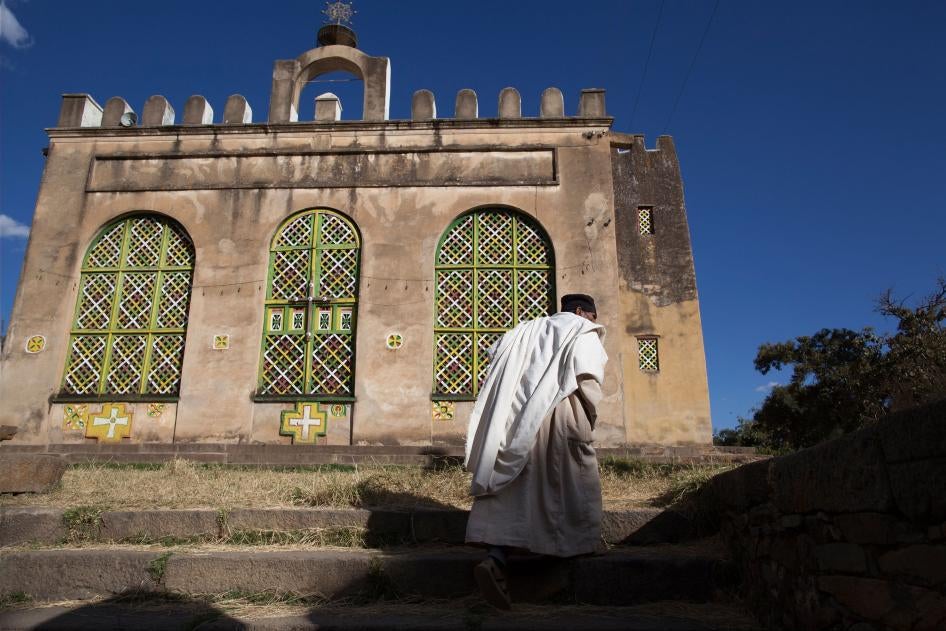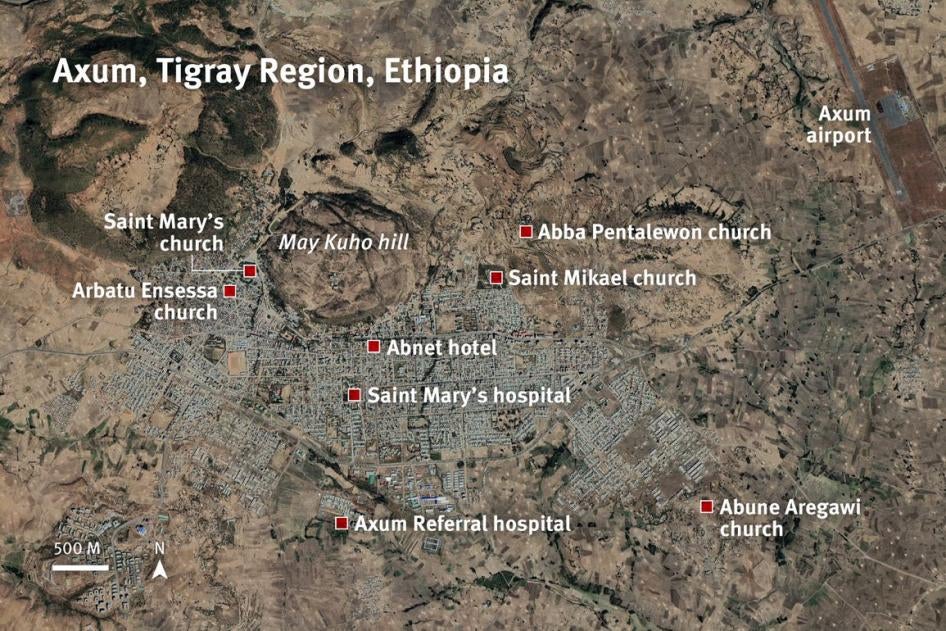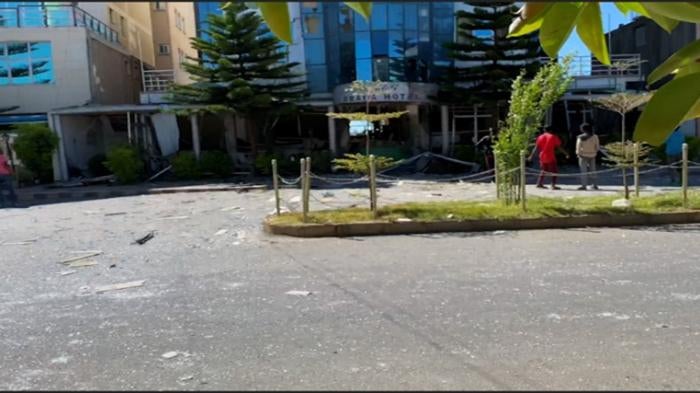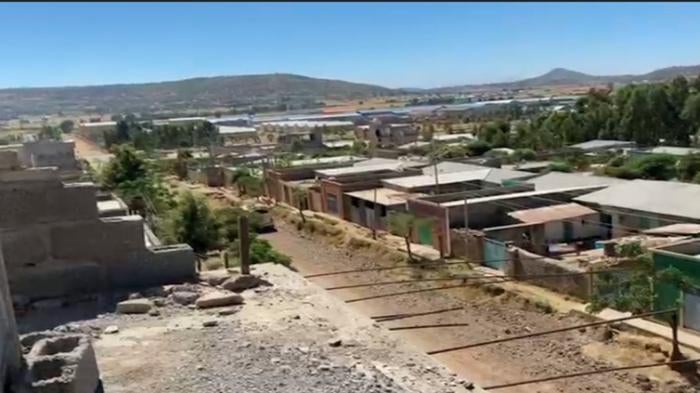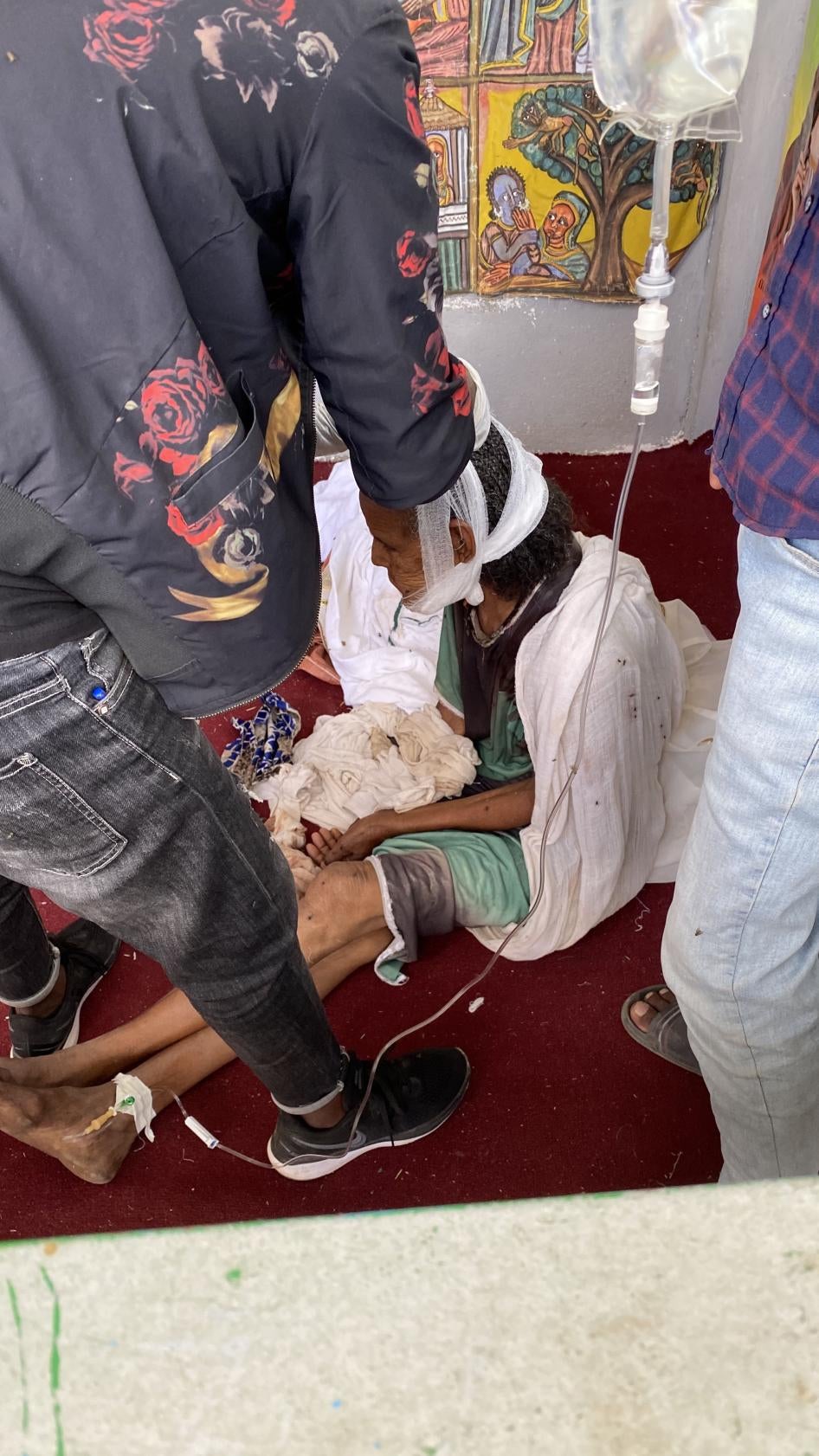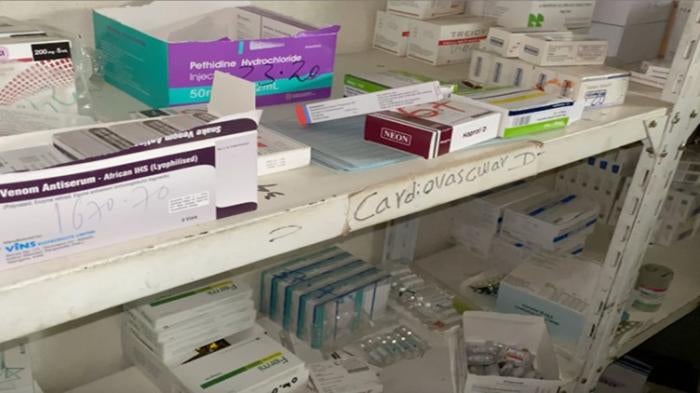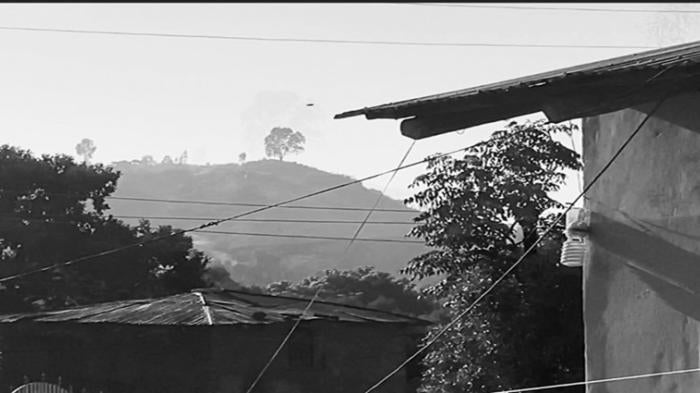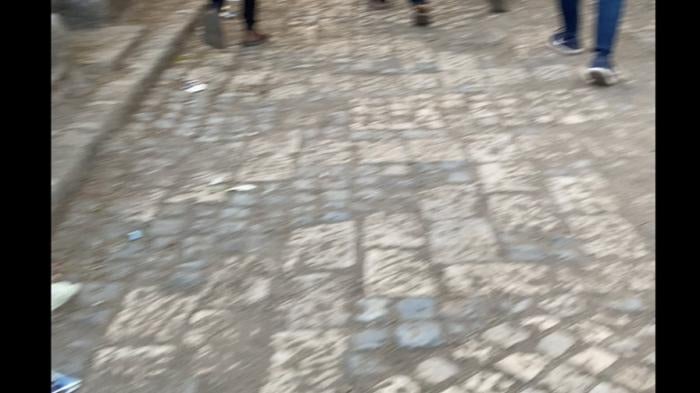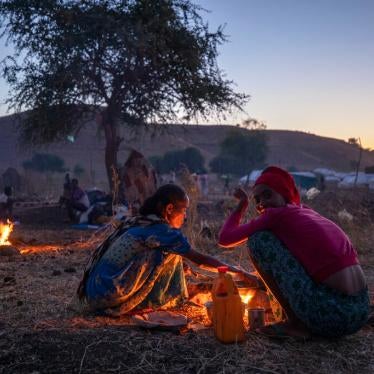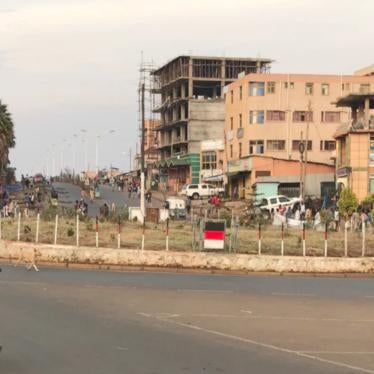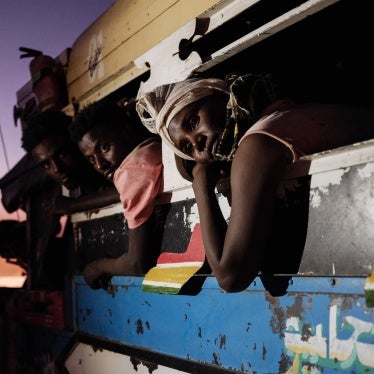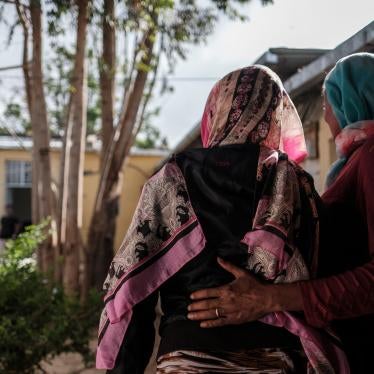(Nairobi) – Eritrean armed forces massacred scores of civilians, including children as young as 13, in the historic town of Axum in Ethiopia’s Tigray region in November 2020, Human Rights Watch said today. The United Nations should urgently establish an independent inquiry into war crimes and possible crimes against humanity in the region to pave the way for accountability, and Ethiopian authorities should grant it full and immediate access.
On November 19, Ethiopian and Eritrean forces indiscriminately shelled Axum, killing and wounding civilians. For a week after taking control of the town, the forces shot civilians and pillaged and destroyed property, including healthcare facilities. After Tigray militia and Axum residents attacked Eritrean forces on November 28, Eritrean forces, in apparent retaliation, fatally shot and summarily executed several hundred residents, mostly men and boys, over a 24-hour period.
“Eritrean troops committed heinous killings in Axum with wanton disregard for civilian lives,” said Laetitia Bader, Horn of Africa director at Human Rights Watch. “Ethiopian and Eritrean officials can no longer hide behind a curtain of denial, but should allow space for justice and redress, not add to the layers of trauma that survivors already face.”
The attacks in Axum followed weeks of fighting between the Ethiopian military and allied forces from the Amhara region and Eritrean troops against forces affiliated with the region’s former ruling party, the Tigray People’s Liberation Front.
Between December 2020 and February 2021, Human Rights Watch interviewed by phone 28 witnesses and victims of abuses and their relatives in Axum and examined videos of attacks and their aftermath.
Survivors consistently identified Eritrean troops by the vehicles bearing Eritrean license plates, their distinctive uniforms, the spoken dialect of Tigrinya, and their plastic “congo” shoes, worn by Eritrean forces since the liberation struggle.
On November 19, after Tigrayan forces and militia withdrew from Axum, Ethiopian and Eritrean forces began shelling the town around 4 p.m., continuing into the evening. The next day, witnesses saw Ethiopian and Eritrean forces indiscriminately shoot at civilians, including in the town’s Saint Mary’s hospital.
For about a week, the military forces pillaged. While several residents who spoke to Human Rights Watch saw Ethiopian forces participate, most said the soldiers just stood by and watched. “It was painful,” said one man. “I thought the Ethiopian military stood for Ethiopia and its people… but they did nothing as Eritrean forces looted and killed. They just kept silent.”
The abuses generated considerable anger in the town. On November 28, after 7 a.m., a group of Tigrayan militia and town residents attacked Eritrean forces, triggering fighting. That afternoon, Eritrean reinforcements entered Axum and went on a 24-hour killing spree.
Survivors described the horror of Eritrean soldiers moving through the town, going house to house, searching for young men and boys, and executing them. A student described watching helplessly as Eritrean soldiers led six neighbors, including a 17-year-old the witness knew as “Jambo” and another young man, outside. He said: “They made them take off their belts, then their shoes. They lined them up and walked behind them. The Eritrean soldiers fired their guns. The first three then fell. They fired other shots, and the other three fell.”
Eritrean troops shot other civilians on the street. “A group of soldiers killed a man and then forced a pregnant woman and two children that were with him to kneel on the asphalt street beside his body,” said one witness.
Those retrieving bodies for burial did not escape harm. Several residents said Eritrean forces shot at them while they tried to collect the dead on November 28 and 29.
The massacre left the town’s inhabitants reeling. One man visited a relative who lost her children in the house-to-house killings: “They killed her children and locked the compound door behind them, so no one could get in at first. She was left alone with the bodies of her two dead children for a day and a half. She was numb, unresponsive by the time we saw her.”
Human Rights Watch was unable to determine the number of civilian deaths resulting from the joint Ethiopian-Eritrean offensive on Axum and the ensuing massacre. However, based on interviews with elders, community members collecting identification cards of those killed, and those assisting the retrieval of the dead, Human Rights Watch estimates that over 200 civilians were most likely killed on November 28-29 alone. Human Rights Watch also received a list of 166 names of victims allegedly killed in Axum in November, 21 of which correspond to the names of those killed on November 28 and 29 given by witnesses interviewed.
International humanitarian law, or the laws of war, applicable to the armed conflict in Ethiopia’s Tigray region, prohibits deliberate attacks on civilians and attacks that are indiscriminate or cause disproportionate civilian harm. Indiscriminate attacks strike military objectives and civilians or civilian objects without distinction, including those not directed at a specific military target. The laws of war also prohibit all violence against captured combatants and civilians, including murder and torture. Pillage and looting are also prohibited. Individuals who commit serious laws-of-war violations with criminal intent, including as a matter of command responsibility, are liable for war crimes.
Crimes against humanity include murder and other unlawful acts committed as part of a widespread or systematic attack on a civilian population.
The late November attacks were documented by media organizations, as well as by Amnesty International. The Ethiopian Human Rights Commission has also begun investigations. Human Rights Watch provided its findings to Ethiopian and Eritrean government officials on February 18 but received no response. On February 26, the Ethiopian government announced it would thoroughly investigate events in Axum and expressed “readiness to collaborate with international human rights experts.”
While the lack of access to conflict areas has hindered reporting on the conflict, Human Rights Watch and others have reported on other massacres, the indiscriminate shelling of towns, widespread pillaging, including destruction of crops, and the apparent extrajudicial executions by Ethiopian and Eritrean forces, as well as forces from the neighboring Amhara region.
Given the presence of multiple armed forces and groups and the poor track record of the warring parties in investigating grave abuses, the UN Office of the High Commissioner for Human Rights (OHCHR) should conduct an urgent, independent inquiry focused on establishing the facts, collecting forensic and other criminal evidence, and investigating war crimes and possible crimes against humanity in Axum and elsewhere, Human Rights Watch said.
“Condemnations are not enough to bring justice to the victims of grave abuses committed by both Ethiopian and Eritrean forces in Tigray,” Bader said. “Attention and action by UN member states is needed now to ensure those responsible for these grave abuses are held accountable. So far, reports of these chilling abuses have been met by shameful silence.”
For background information and further accounts of the Tigray conflict, please see below.
Attack on Axum, November 19-20
Axum is in northern Tigray, home to an ancient civilization, and declared a World Heritage Site in 1980 by the United Nations Educational, Scientific and Cultural Organization (UNESCO). Following the outbreak of armed conflict in Tigray in early November, many residents fled the fighting in western Tigray by crossing into Sudan or by going east, including to Axum, where they hoped to find a safe haven given the town’s historical and religious significance.
Axum residents were already feeling shortages because of the conflict. Ethiopia’s federal government cut off access to Tigray at the war’s start and food was in short supply. “Electricity was shut,” one resident said. “We couldn’t grind the grains. People subsisted on crackers. After a week, there was nothing. This affected everyone.”
In mid-November, airstrikes hit an area near Axum’s airport.
On November 19, residents heard the distant sounds of artillery getting closer from the direction of Shire, a town 40 kilometers west that Ethiopian federal forces had captured two days before. Several residents then saw Tigray special forces and militia withdraw from the town. “People were scared because of the terror in Shire,” said a man who fled to Axum. “No one opened their shops or the market.”
At about 4 p.m., Ethiopian and Eritrean forces fired artillery into Axum that struck buildings, hit the town’s cobblestoned streets, and killed and injured civilians. Panicked residents sought cover from the shelling, some hiding in their homes, others fleeing to rural areas, following a pattern of attacks already documented by Human Rights Watch during the conflict.
Artillery hit the wall of a house in Kebele 02, killing four civilians inside. One young man said: “We were scared, this was our first experience with war. We didn’t know what they were targeting. A heavy weapon hit a home. The blast scattered the bodies of Kassa Enquay, Almaz Zeraya, Ammanuel Berhe, and a young woman who worked as a housekeeper.”
The shelling continued until evening. Residents then heard gunfire.
Around 8 a.m., the next morning, residents saw Ethiopian and Eritrean armed forces move unopposed into Axum from two directions. One said: “At first, I saw and heard nothing, it was like a horror movie, eerily quiet ... But then I started hearing unusual sounds. I went out and saw the sound was from the tank treads on the asphalt road. The soldiers started shooting, causing everyone to run.”
A man saw his barber, Mebratu Muruts, shot by a mixed group of Ethiopian and Eritrean soldiers: “He tried to run. They shot at him four times before he finally fell.”
Eritrean forces shot patients in the town’s Saint Mary’s hospital, killing both civilians and wounded Tigrayan fighters. A man from a nearby village brought his sister for treatment at the hospital but Eritrean forces fatally shot her as well: “My sister was in the bed. I was in the chair beside her. Suddenly, the [Eritrean forces] came in and started shooting. She got hit by a bullet and I started to run. After killing people, they took medicine, beds, and other equipment.”
Widespread Pillaging, November 20 to 27
For a week, Eritrean forces raided neighborhoods and pillaged homes, banks, pharmacies, and jewelry, electronic, and souvenir shops – hauling away the stolen goods on trucks.
A man displaced from the town of May Gaba saw Eritrean soldiers break into a neighboring compound. “There was a big water tank, they emptied all the water, then stole the tank and pump,” he said. “They even took children’s toys, small bicycles. They took everything, all they could, on the truck.”
The widespread pillaging of medicine, beds, and equipment from Axum’s medical centers prevented injured and sick people from getting treatment. A day laborer said: “Eritrean soldiers took all the medicine from the pharmacy, especially from Axum’s referral and Saint Mary’s hospital. They loaded it onto Tata trucks with Eritrean license plates and left toward Adwa [a town east of Axum in Tigray]. So for those that needed or could afford to buy it, there was nothing available.”
A resident said that on November 30, he tried to get urgent medical care for a woman injured by the shelling:
I found her in pain and unable to talk. Her lower jaw was hanging down. I tried to clean her wound and made her lie down in Saint Mary’s church. She had fled Humera, but the war caught up to her here.
I recognized two nurses trying to flee town. I convinced them to help me take her to Saint Mary’s hospital. When we arrived, we found the pharmacy looted. Everything was gone.
A video sent to and analyzed by Human Rights Watch seems to show the pharmacy of Saint Mary’s hospital on November 30. The video shows a room with drawers open, shelves with empty medicine boxes, and packages dumped on the floor. The date given through interviews with the videographer corresponds with the date in the video’s metadata.
Several residents saw Ethiopian soldiers participate in the looting. One witness said: “The Ethiopian troops searched houses, they broke the window and gate of the Branna hotel, destroyed government offices and Dedebit bank, and robbed the money.”
Most, however, said that the Ethiopian soldiers stood by and watched the violence. “I asked one soldier, why are you not doing anything, you are Ethiopian, and we are in Ethiopia; you are allowing the Eritreans to do this,” said one resident when he complained to Ethiopian forces about the looting. “He told me: ‘We need an order from above.’”
Ambush and Fighting on November 28
Four residents said that on November 26 they watched a group of Ethiopian federal forces leave Axum with heavy weapons, heading toward Shire. Before they left, one resident approached an Ethiopian soldier who told him: “We have to leave Axum, you guys watch your city. Good luck.”
On November 27, about 50 more Eritrean soldiers arrived and set up a base near a technical college on May Quho hill. Others were stationed near the old airport area.
The shelling and widespread pillaging had created anger and tension in the town. “Eritrean soldiers had beaten and killed people; they looted so much property,” said one young resident. “So we were emotional and upset about what they were doing to Axum people.”
On November 28, at about 6 a.m., 10 to 30 Tigrayan militia members lined up behind the historic Saint Mary’s church and headed toward May Quho.
Residents, mainly young men and boys, joined on impulse. Two participants said that local youth managed to take weapons, including Kalashnikov pattern rifles, from an abandoned Tigrayan forces camp, while others carried sticks, knives, and stones.
One participant in a group of 16 youth said:
Some young people got weapons, such as Kalashnikovs, from a weapons store at a camp. I was there when they got the weapons. We didn’t discuss this beforehand, none of us were trained, but all of us were angry, sad, and emotional about the looting, killings, and beatings of people. A few people joined, and then others followed.
Witnesses saw youth attack and kill about 10 Eritrean soldiers getting water near May Quho. Gunfire then erupted and Eritrean forces fired towards the town and onto the hill, residents said.
Peaceful churchgoers leaving morning prayers at Saint Mary’s church were not spared. Four congregants said the gunfire sent hundreds running. One worshiper said: “We were leaving church when we heard gunshots. I saw a woman aged around 50 and another person fall on the ground as I ran. I dodged the firing by running house to house until I reached my home.”
One youth who tried to deliver food to the militia members saw several young men die in the clashes, including a resident, Tegazu.
A man watched residents heading to the hill from his hotel: “I saw someone carrying two guns in his hands. He asked, ‘How do I shoot these guns?’ A little boy was joining the battle.” Later, he saw Eritrean snipers shoot at youth in the town and at those trying to get up the mountain. “The young boy who passed by the hotel earlier fell from the mountain,” the man said. “He wasn’t older than 12.”
Clashes lasted until 4:30 p.m. when Eritrean forces called for reinforcements. They arrived firing heavy weapons from the direction of Adwa, forcing the militias and youth to stop fighting and retreat back into town.
Human Rights Watch reviewed a video of the gunfire exchange on May Quho, which confirms witness accounts. The 6:22 minute video contains four scenes edited together. The first scene shows at least 10 people running up May Quho amid constant gunfire. The second scene shows a group of at least 16 young men in civilian clothing, unarmed, with no visible or makeshift weapons gathered at the bottom of the hill. One man is carrying a child on his hip. By matching key landmarks visible in the video with satellite imagery, Human Rights Watch was able to establish that the group was standing at the bottom of May Quho, approximately 70 meters northeast of the Queen Sheba’s bath and 580 meters from Saint Mary’s church.
Massacre on November 28 and 29
Witnesses said that from 4 p.m. on November 28, until the following morning, Eritrean soldiers attacked Axum residents, shooting indiscriminately or summarily executing those they found on the streets or in house-to-house searches. Young men and boys were the evident targets.
A witness saw four Eritrean soldiers kill two people he knew, including a child:
Haftom Kalem was young, maybe 16 or 17. He was near Saint Mary’s church. I saw him running when Eritrean forces yelled at him to stop. He kept running, and they finally shot him. A teacher, Alemshewit Gebrewahid was next. He was at home and opened the door to see what was going on. The four soldiers noticed him. He was screaming: “What did I do? I don’t know anything. I am a civilian.” One soldier shot him twice.
They seemed to be cleansing the area.
A driver saw six Eritrean soldiers lead six people, including two of his friends, out of a motel near May Quho where they had been hiding, and shot them dead. He said:
I was hiding in a room on the third floor watching from the window when the soldiers came and led Mulu, John, [two other men], and two women outside. They made the four men line up in front of the wall. The two women pleaded with them [the soldiers]. They pointed their guns at the women and told them to keep quiet. My two friends were killed. Mulu was shot in the chest. John, in the neck.
Soldiers also shot and killed civilians on the street. One man saw Eritrean forces shoot his friend Tesfaye on November 28. “The Eritrean soldiers came in front of him,” he said. “He had a bottle of water and biscuits in his hand that we bought together earlier and that he planned to have for dinner. He [Tesfaye] raised his hands as they shot him.”
A student found the main and side streets filled with dead bodies. He recognized the bodies of four friends in front of Abnet Hotel: Ashenafi Berhane, about 13; “Jambo”, 17; Yonas, 20; and Negash Saleh, 19. He said:
They all had bullet wounds. Most shot in the abdomen. Yonas in his back.
I went to Jambo’s mother. When I entered the house, everyone was crying. His mother rushed up to me and grabbed my hand, she kept asking: “Where is Jambo? Where is Jambo? Where did you leave him? Why did you leave him?” I was crying, she was crying, I could say nothing to her, I didn’t know what to say. Then someone said [about me], “He knows he’s dead.”
As the sounds of gunfire seemed to decrease, residents attempting to pick up the bodies were shot at. One said:
We saw dead bodies near the NIB bank. A woman was among the dead – she was wearing a netela [traditional white cloth] and was in her 30s. The rest were young. As we were trying to collect the bodies, weapons were fired toward us, so we left the bodies and ran home.
Some residents, however, managed to pick up bodies from the streets on November 29. Human Rights Watch reviewed a video showing a body being carried on a stretcher. An identity card from the Commercial Bank of Ethiopia displaying the name and picture of Gebrehiwot Gebrekidan is shown to the camera. A woman uncovers the face of the deceased revealing his face. The facial hair and age are consistent with the photograph on the identity card. Gebrehiwot Gebrekidan was among the list of men killed. According to the metadata attached to this video, it was recorded on November 29.
By evening on November 29, Eritrean forces had detained hundreds of men and boys and held them in at least three sites. Witnesses saw soldiers execute some of the detained men. Three Eritrean soldiers entered Saint Mary’s church and detained men sheltering there. One witness said:
They took men near the entrance. A laborer from Humera who had been living in the church was selected. He was too weak to stand and refused. So they killed him. They took around 50 people from inside the church. I saw a young monk, Aba Berihun, picked. They led them out barefoot. I was deep in the church hiding among the elders. I was lucky not to be taken.
Two residents held at makeshift sites, in open pits, near the airport said they were guarded by female Eritrean soldiers, threatened, and told to hand over weapons. One man said:
They called one man over, and maybe he wasn’t fast enough, or did not obey them enough, but they called him and his two friends and shot them in front of us. This was to intimidate those detained, for us to disclose information. After seeing them killed, we just waited for our turn.
Three men held said Eritrean soldiers mocked and threatened them. By evening one Eritrean soldier ordered the detainees’ release but threatened they would meet the same fate as those killed if they resisted further, two witnesses said. “They pressured us to help them locate the Tigray forces, and vowed to destroy the city if we fought or didn’t obey them,” said one man. “I was in disbelief when we were released,” another said. “I just ran away; I have never run in my whole life like I did in that moment.”
Burials and Psychological Trauma
The religious festival of Saint Mary, held annually on November 30, typically draws thousands of pilgrims and tourists to Axum. The community, however, commemorated the day by collecting bodies onto carts or tragically learning of the loss of loved ones. “Our festival became a funeral,” said a mourner.
Another man said it was “a dark and bloody day for everyone.… A person was missing from every house. They had either been killed, ran away to rural areas, or no one knew their whereabouts.”
A day laborer who collected about 20 bodies on November 30 said: “We started at 8 a.m. I picked up bodies near the church, the bus station, and the Abnet Hotel on the main asphalt road. They had been left out for two days and started to smell.”
Several residents said that journalists from Ethiopian state media started recording to show the town was peaceful. One man was at church burying someone he knew: “Instead of allowing people to mourn, they recorded us and pretended people were gathered for our [religious festival].”
Community members collected bodies from locations throughout Axum, in the streets, outside homes, and on May Quho. “Hyenas had eaten the corpses on May Quho, so we didn’t collect many dead bodies from there,” said one man carrying the dead. “I counted around 25 remains that could not be identified.” Another said: “The hill was like a graveyard, a ghost hill.”
Residents found Ashenafi, about 15, shot dead outside the three steps of a restaurant, his hands still clinging to the outdoor fence. A man who helped collect bodies and wrap them in plastic sheeting said: “I saw one woman come up to a cart. She was trying to see the bodies. She removed one plastic sheet, saw the man was her son, and collapsed.”
Victims were buried in existing cement chambers in Arbatu Ensessa church, or in mass graves, a practice out of step with Orthodox Christian funeral rites in grave sites around Saint Mikael, Abune Aregawi, Enda Yesus, and Abba Pantelewon churches. Several residents said that over a dozen Muslims were also buried in Mekabr Eslam, a burial site a few kilometers north of Saint Mary’s church. One man participating in burials explained how the names of those killed were identified and registered:
Family members recognized the dead. Or we found out through identification cards kept at the churches. If not, a sample of the clothing or shoes they wore was left at the church so that people could go identify their loved ones. A few were unidentified, whether Christian or Muslim, whether migrants from western Tigray. So we buried them along the China road.
The attacks and killings are likely to inflict long-term trauma and harm to survivors and the community. One resident said: “After burying, I couldn’t sleep. I have never seen so many dead bodies like that in my life.”
Aftermath
Though Eritrean forces left Axum and moved toward neighboring villages, residents still saw some troops in and out of the town afterward. These soldiers, along with thieves, continued to loot. “I saw three Eritrean soldiers break the door to my wife’s shop, but there was nothing I could do,” said one man. “When I came back, nothing was left in the store.”
In December, a woman visiting her family described Axum as “a dark city where everyone lived in fear of soldiers. Everything was looted, shops weren’t open, and there was no food, light, or water. I drank water dug from a hole.”
The pillaging of medical equipment and medicines from hospitals meant that many with medical needs were left unassisted. “My wife was pregnant and near delivery,” one man said in February. “But there was no electricity, no network to call for help. The health workers fled to the villages. My child is still not vaccinated.” Aid agencies that arrived in January and February found healthcare centers nonfunctional, and a population living without electricity, with shortages of water and food, and in need of critical assistance.
Survivors who fled or remained in Axum spoke consistently of the collective pain and trauma the community experienced, but also their shock and anger at the government. “The Eritrean [soldiers] did this without fear,” said one resident in February. “The Ethiopian government should have protected us. Up to now, no one came to check on us to see what was going on.”
